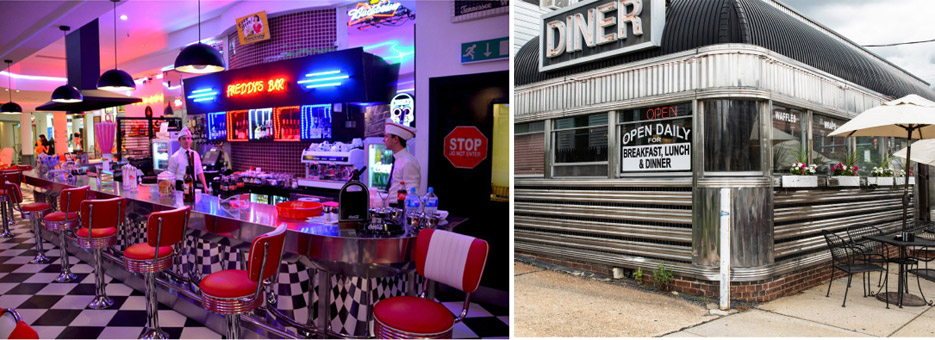The Stone Detective: A Lesson in Deflection
Frederick M. Hueston, PhD
Most of you are familiar with my favorite greasy spoon – I go there almost every morning. I have mentioned it in almost all my stories, but I have never described what it looked like. I thought I would give everyone a tour and, actually, that leads to this month’s stone puzzle.
If you have ever visited New Jersey and had the experience of eating in one of their dinners, then the following description is a textbook New Jersey diner motif, just located in Florida. The outside of the diner is all chrome. There is a small front door that sticks when you push it (well, maybe that’s not standard). When you walk in, you immediately think you have gone back in time to the 1950s. The interior is red and black with a lot of black and white tile. The stools at the counter are covered in worn, red vinyl. There are a few tables opposite the counter. The grill and the entire kitchen is behind the counter – similar to the set up in a Waffle House. (See my photos below of some examples.) The countertops are Formica with a swirling pattern that looks like onyx.

I never really paid attention to the countertops until this morning. I was sipping my cup of joe and got a text that said: Hello Mr. Stone Detective, I am an interior designer and have a large onyx tabletop that is cracking, can you please call me to discuss? As I was reading the text Flo came over, filled my coffee cup and pointed to my phone and said, “Another fan?” I laughed and told her what it said. She asked me what onyx was. I started telling her that it’s a type of marble formed in water, etcetera, etcetera. I continued my geology lesson until I noticed she had one of those deer in the headlight looks, and no idea what I was talking about. I reached for my phone to get a pic and then I realized that the diner countertop had an onyx-like pattern. I pointed to the countertop and told her it looks like that.
Flo just rolled her eyes and walked away. I finished my breakfast and went back to my office to call the designer lady.
I logged on to my email and found that the designer lady had sent me over a dozen pics of the onyx table. It was rather large, about 4 feet in diameter, and was set on a tall base. I looked closely to see the size of the base and discovered it was only about 12 inches square. I really couldn’t see what was set on the base to support the onyx.
I got on the phone and gave her a call. She told me that the fabricator had placed it on a piece of acrylic and assured her it would be strong enough to support the onyx.
I had my doubts and started examining the photos more closely. The first thing I noted is that the cracks ran all the way across the top. I also noted that the edges of the cracks were lifted upward. This indicates that the stone is deflected. I wrote up a brief letter to explain what was happening. Here is part of the letter I sent her:
The type of cracks observed are the result of deflection. Deflection is the stress placed on the stone which causes a bend in the stone. Since the stone’s flexural strength is limited, when this flexural strength is exceeded, it will result in a crack. This is evidenced in crack dynamics by the pattern of the crack and the lifting of the minerals within the crack as observed in the photographs. The structural acrylic is either not rigid enough to prevent the flexural limits of the onyx or is not properly adhered, allowing the onyx to exceed its flexural limits resulting in the cracks observed.
According to the Marble Institute of America, Bulletin VI, onyx has a flexural strength of 3.4-5.2 MPa*. The following is a direct quote from this bulletin:
“Flexural strength of onyx is low when compared to many other stone varieties and is frequently in the 500 to 750 lbs./in² (3.4 to 5.2 MPa) range. This property, coupled with a brittle breaking behavior, makes bonding area critical. Compliance with the MIA guidelines of coverage and void restrictions is imperative. Additionally, substrate rigidity is critical, and MIA substrate deflection limits must be observed.”
The subbase that is used should exceed this number to properly support the onyx as well as making sure that the onyx is bonded with 100 percent coverage to prevent any deflection.
I sent her my report and have not heard back from her, but have a feeling I will be once she confronts the fabricator. Hope this doesn’t get ugly. Another case solved – sort of.
The Stone Detective is a fictional character created by Dr. Frederick M. Hueston, PhD, written to entertain and educate. Dr. Fred has written over 33 books on stone and tile installations, fabrication and restoration and also serves as an expert for many legal cases across the world. Fred has also been writing for the Slippery Rock Gazette for over 20 years.
Send your comments on the Stone Detective to fhueston@stoneforensics.com .
*Megapascal pressure unit measurement is similar to hydraulic pressure measurement. Primarily used for higher range pressure measurement due to its larger value (e.g. 1 MPa = 10 bar), the MPa is mainly used to describe the pressure ranges and ratings of structural concrete.